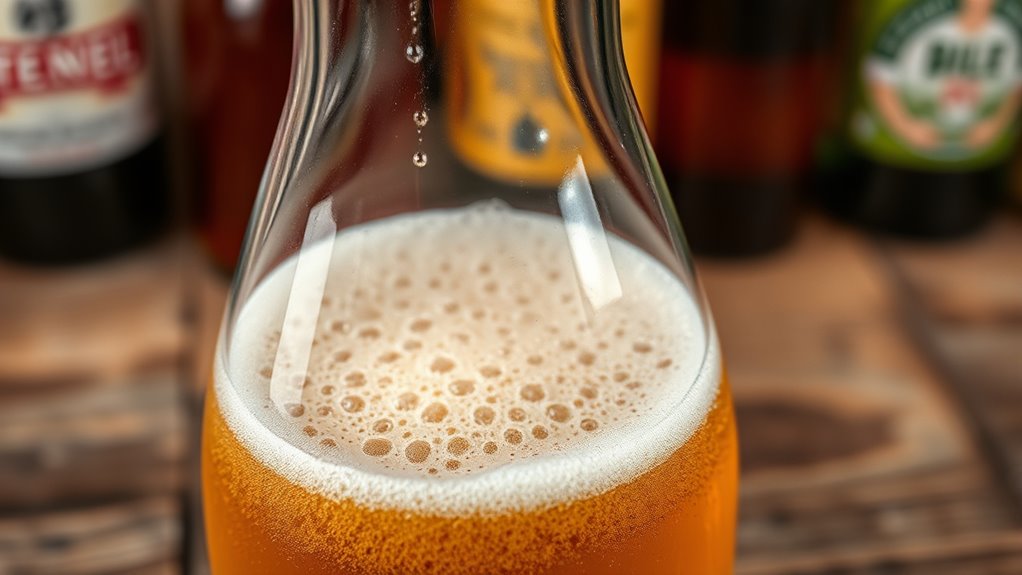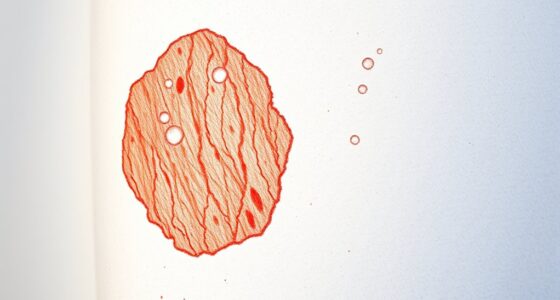Fermentation in wine and beer involves yeast breaking down sugars into alcohol, carbon dioxide, and flavor compounds. Yeast converts glucose in grapes or grains into ethanol and CO₂ through enzymatic processes, providing bubbles and carbonation. Factors like temperature, pH, nutrients, and oxygen levels influence how efficiently fermentation occurs and how the flavors develop. To understand how these conditions shape your favorite drinks, keep exploring more about this fascinating chemistry.
Key Takeaways
- Fermentation converts sugars into ethanol and CO₂ via yeast enzymes, producing alcohol and bubbles in wine and beer.
- Yeast metabolism relies on glycolysis, regenerating NAD+ to sustain continuous sugar breakdown during fermentation.
- Environmental factors like temperature, pH, and nutrient availability influence fermentation efficiency and flavor development.
- Primary fermentation involves rapid sugar conversion, followed by secondary processes like malolactic fermentation in wine.
- Proper control of fermentation conditions ensures desired alcohol content, carbonation, and flavor quality in the final beverage.
The Fundamentals of Fermentation Chemistry
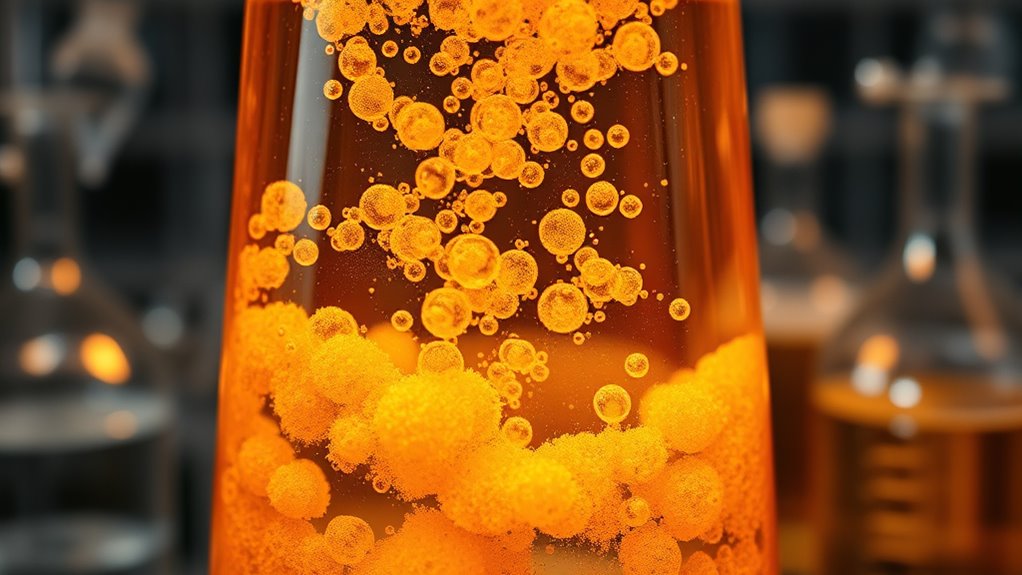
Fermentation is a chemical process that breaks down organic compounds into simpler substances like alcohol or acids, often producing gas in the process. You should understand that this process relies on metabolic pathways like glycolysis, which convert glucose into pyruvate, leading to various end products. During fermentation, energy is generated as ATP through substrate-level phosphorylation or ATP synthase. Redox reactions play a pivotal role, involving electron transfers to cofactors like NAD and ferredoxin. It’s important to note that fermentation occurs under anaerobic conditions, meaning no oxygen is involved. These reactions support microbial growth and produce byproducts like carbon dioxide, which adds pressure and foam to products like beer and sparkling wine. Fermentation also involves the regeneration of NAD+ from NADH, which is essential for glycolysis to continue. This chemistry forms the foundation of many fermentation-based industries, and understanding redox reactions is key to optimizing fermentation processes.
How Yeast Converts Sugars Into Alcohol and CO2

Yeast transforms sugars into alcohol and carbon dioxide through a well-coordinated biochemical process that takes place under anaerobic conditions. First, yeast breaks down sugars like glucose and sucrose into pyruvic acid via enzymatic reactions.
Under oxygen-free conditions, pyruvic acid is then converted into ethanol and CO2. This process also regenerates NAD+, which supplies energy for yeast survival.
The chemical reaction follows a consistent stoichiometry, producing ethanol and CO2 in fixed proportions. As CO2 forms bubbles, it causes dough to rise or creates fizz in beverages.
The efficiency of this conversion depends on factors such as yeast strain, sugar type, and fermentation environment.
Key Factors That Influence Fermentation Efficiency
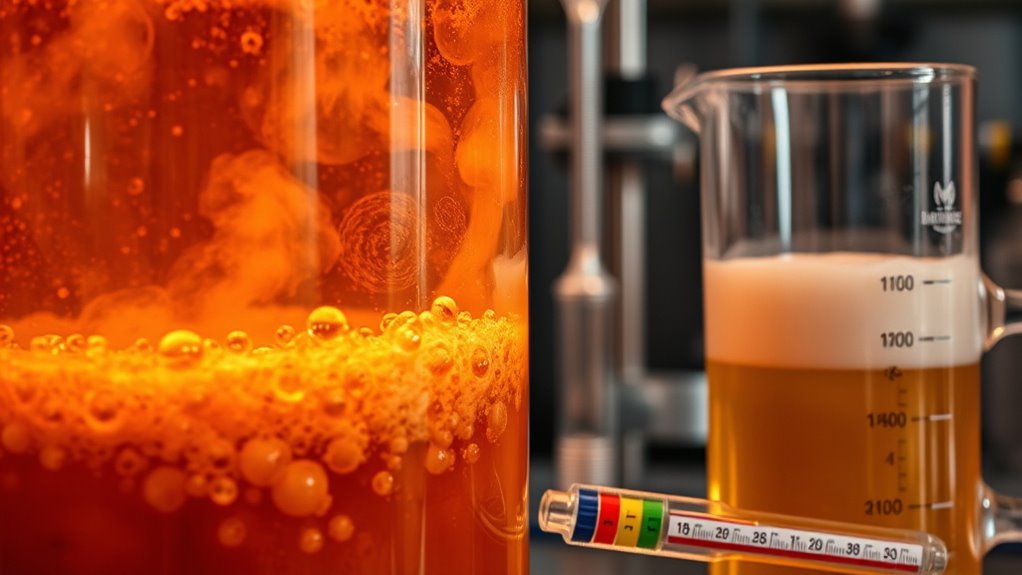
Several key factors determine how efficiently fermentation proceeds, and understanding them can help you optimize the process. Temperature plays a critical role; if it’s too cold, yeast activity slows, delaying fermentation, while higher temperatures can boost activity but risk off-flavors. Maintaining consistent temperatures tailored to your microorganisms prevents spoilage. Temperature control ensures metabolic activities proceed optimally. pH and acidity also impact microbial growth and metabolic functions, influencing flavor and preventing unwanted bacteria. Proper nutrient availability is essential—without enough nutrients, fermentation stalls, reducing alcohol yield. Limited aeration is generally best; too much oxygen can shift yeast metabolism toward undesirable by-products. Additionally, the choice of fermentation technology can influence efficiency and scalability, depending on your production needs. Finally, the specific microbial populations and genetic traits, like yeast strain selection and contamination control, directly affect fermentation speed, efficiency, and product quality. Managing these factors guarantees a smooth, efficient fermentation process.
Distinctive Stages in Wine and Beer Fermentation Processes

Understanding the distinct stages in wine and beer fermentation helps you manage the process more effectively. Primary fermentation lasts about 3 to 5 days, with most activity occurring during this time. Yeasts vigorously convert sugars into ethanol and carbon dioxide, producing noticeable bubbling and foaming. Rich in vitamins and minerals, fermentation also involves the production of antioxidants that can benefit health. In wine, this stage is typically aerobic, with exposure to air aiding yeast growth, while beer fermentation is usually anaerobic, starting with some oxygen in the headspace. Once primary fermentation concludes, wine often undergoes secondary fermentation, like malolactic fermentation, which softens acidity and adds complexity. In beer, secondary fermentation involves conditioning and maturation, reducing harsh flavors and developing carbonation. Each stage plays a vital role in shaping the beverage’s final character and quality.
The Impact of Fermentation Conditions on Flavor and Quality
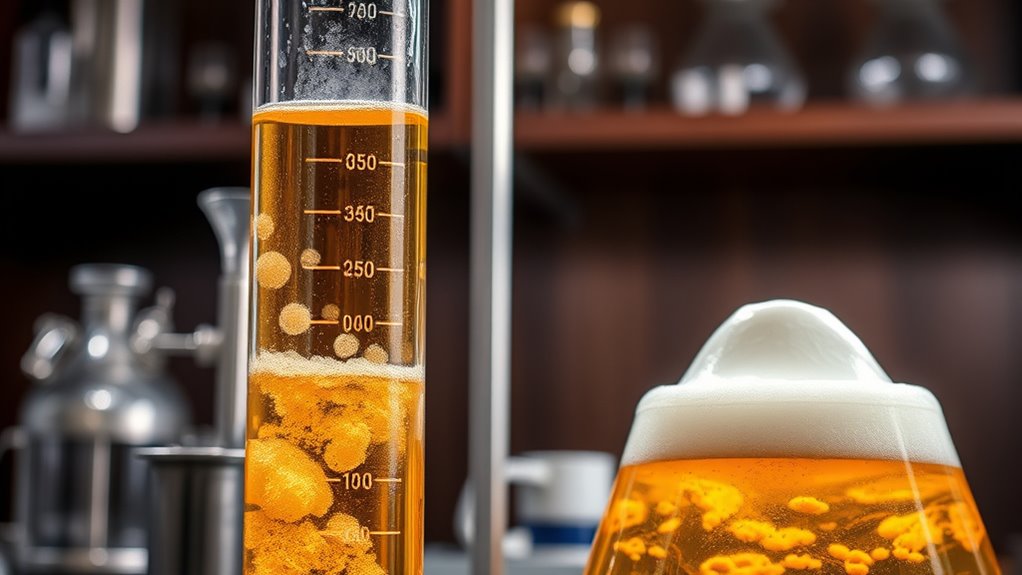
Fermentation conditions such as temperature, pH, and timing have a direct impact on the flavor and overall quality of wine and beer. Temperature controls microbial activity, shaping the types and amounts of flavor compounds produced. Yeast activity peaks between 20–30°C, but extreme temperatures can cause off-flavors or inhibit fermentation. Elevated temperatures around 45–50°C may increase flavor complexity but risk stress responses. pH influences yeast and bacterial growth, affecting acidity and aroma; slight acidity (pH 3.5–4.5) favors desirable flavors. Proper filter maintenance and control of environmental factors are essential for consistent results. Timing also matters: longer fermentation can deepen flavors, but overly extended periods may produce unwanted metabolites. Precise control of fermentation duration helps preserve aromatic compounds and maintain consistency.
Frequently Asked Questions
How Do Different Yeast Strains Affect Final Beverage Flavors?
Different yeast strains shape your beverage’s final flavor by producing unique compounds during fermentation. They influence aroma, taste, and mouthfeel, from fruity and spicy notes to creamy textures or sharp finishes.
By selecting specific strains, you control these flavors, and blending strains can create layered complexities.
Your choice impacts not just flavor but also fermentation speed and by-product formation, helping you craft a beverage that matches your desired profile.
What Are the Environmental Impacts of Large-Scale Fermentation Processes?
You see, large-scale fermentation impacts the environment through greenhouse gas emissions, water use, and energy consumption. It releases CO2, contributes to climate change, and demands significant resources.
Yet, it also offers benefits—reducing reliance on fossil fuels, conserving ecosystems, and lowering overall pollution.
Can Fermentation Be Optimized Without Temperature Control?
You can optimize fermentation without strict temperature control by focusing on nutrient supply, pH regulation, and aeration. Selecting hardy strains and adjusting media help maintain microbial activity despite temperature fluctuations.
Continuous monitoring allows you to tweak parameters dynamically, while kinetic models guide process adjustments.
Although challenges like slower rates or by-products exist, combining these strategies enables you to achieve efficient fermentation without relying solely on precise temperature regulation.
How Does Fermentation Influence the Nutritional Content of Wine and Beer?
You might find it fascinating that fermentation can increase antioxidant levels in wine, with phenolic compounds rising by up to 20%. It also boosts B vitamins, especially in beer, and enhances folate content.
Are There Health Risks Associated With Fermentation Byproducts?
You should be aware that fermentation byproducts can pose health risks. Excessive alcohol intake can lead to liver issues and cancer.
Biogenic amines like histamine might cause headaches or allergic reactions. Contaminants from improperly fermented products can also cause food poisoning.
Additionally, some byproducts may worsen symptoms in sensitive individuals. To stay safe, choose products made under controlled conditions and consume in moderation, especially if you have health concerns.
Conclusion
Understanding the chemistry behind wine and beer fermentation reveals how precise conditions shape flavor and quality. Did you know that yeast can convert up to 97% of available sugars into alcohol? This incredible efficiency highlights how small tweaks in temperature or sugar levels can dramatically influence your brew’s taste. By mastering these fermentation factors, you can craft beverages that are not only enjoyable but also perfectly tailored to your preferences. Cheers to the fascinating science behind your favorite drinks!
